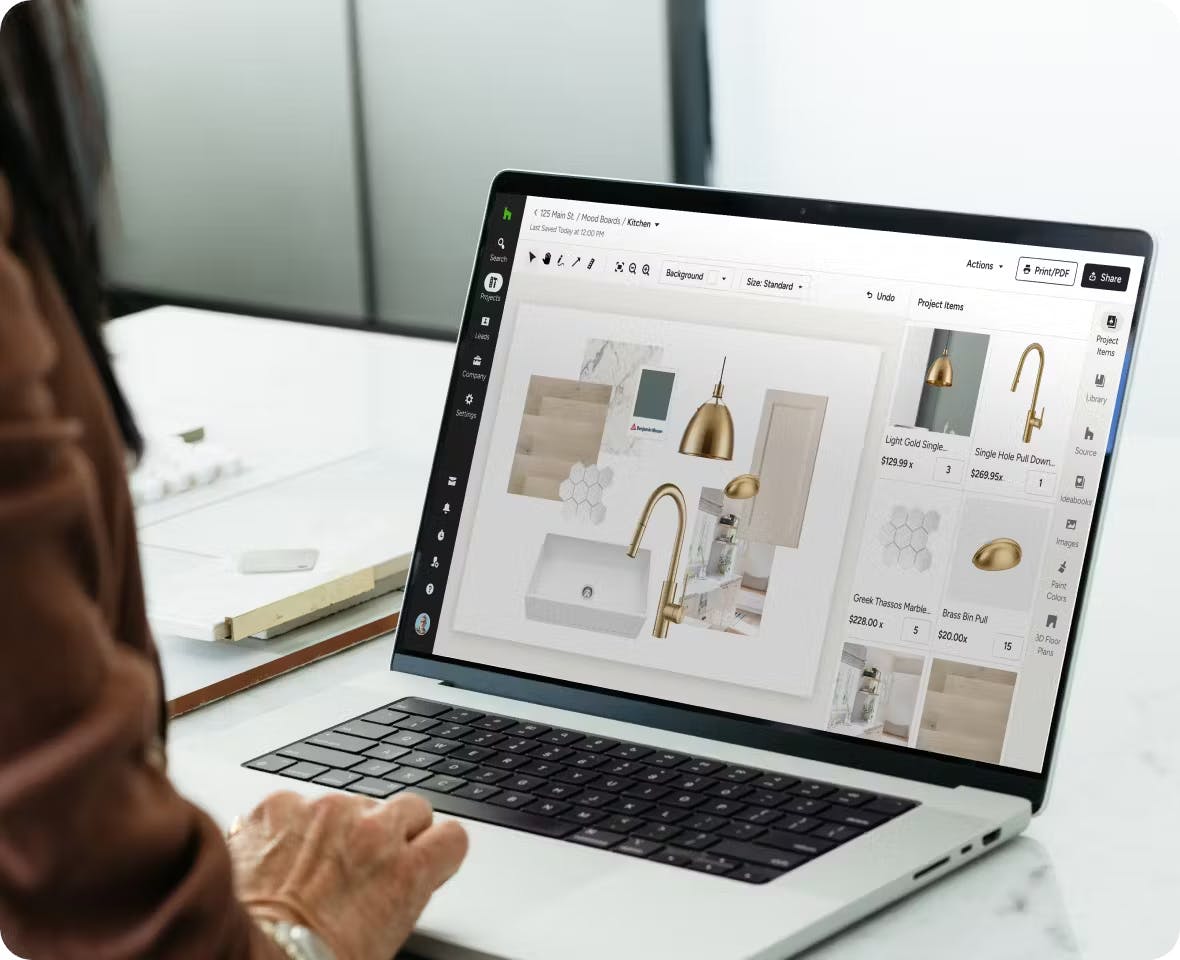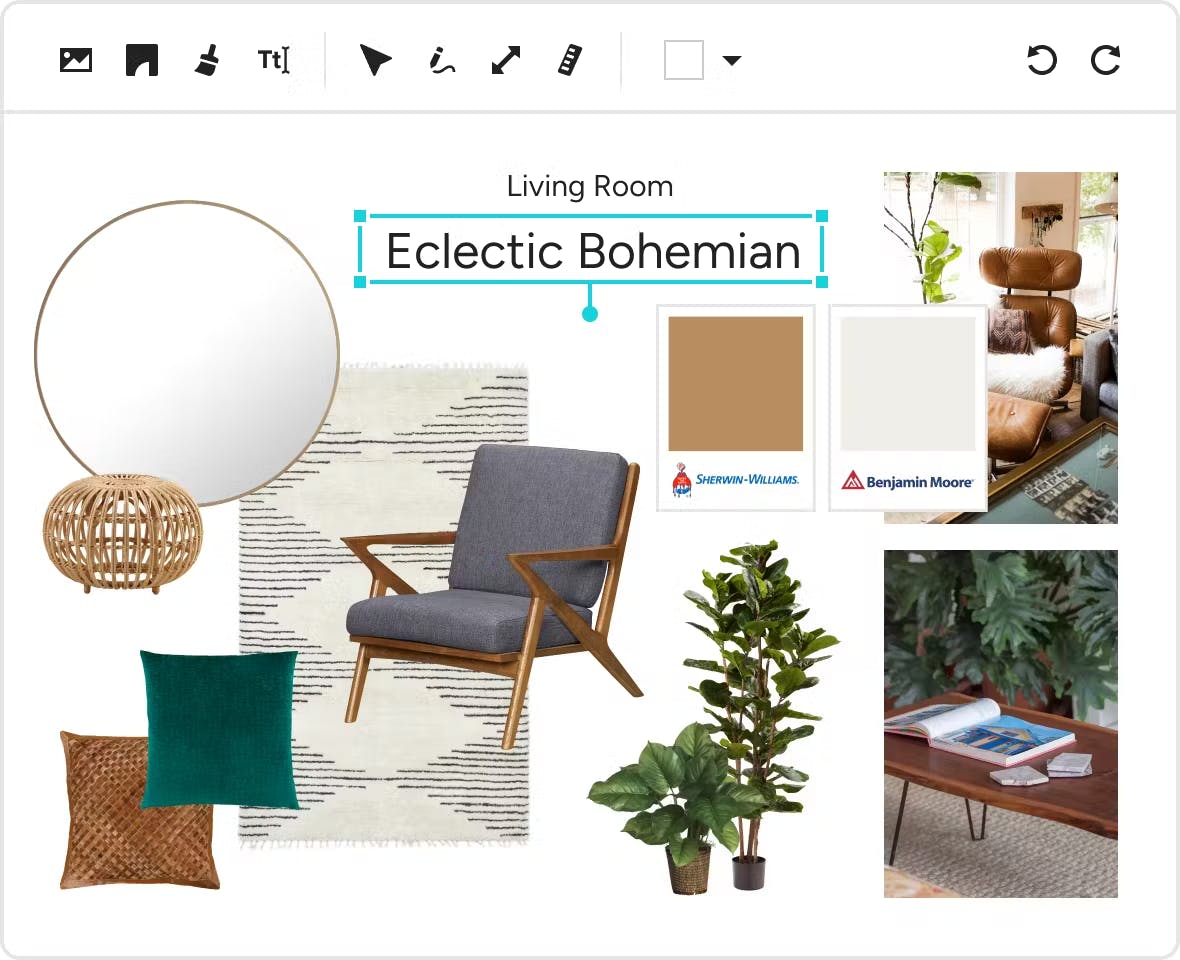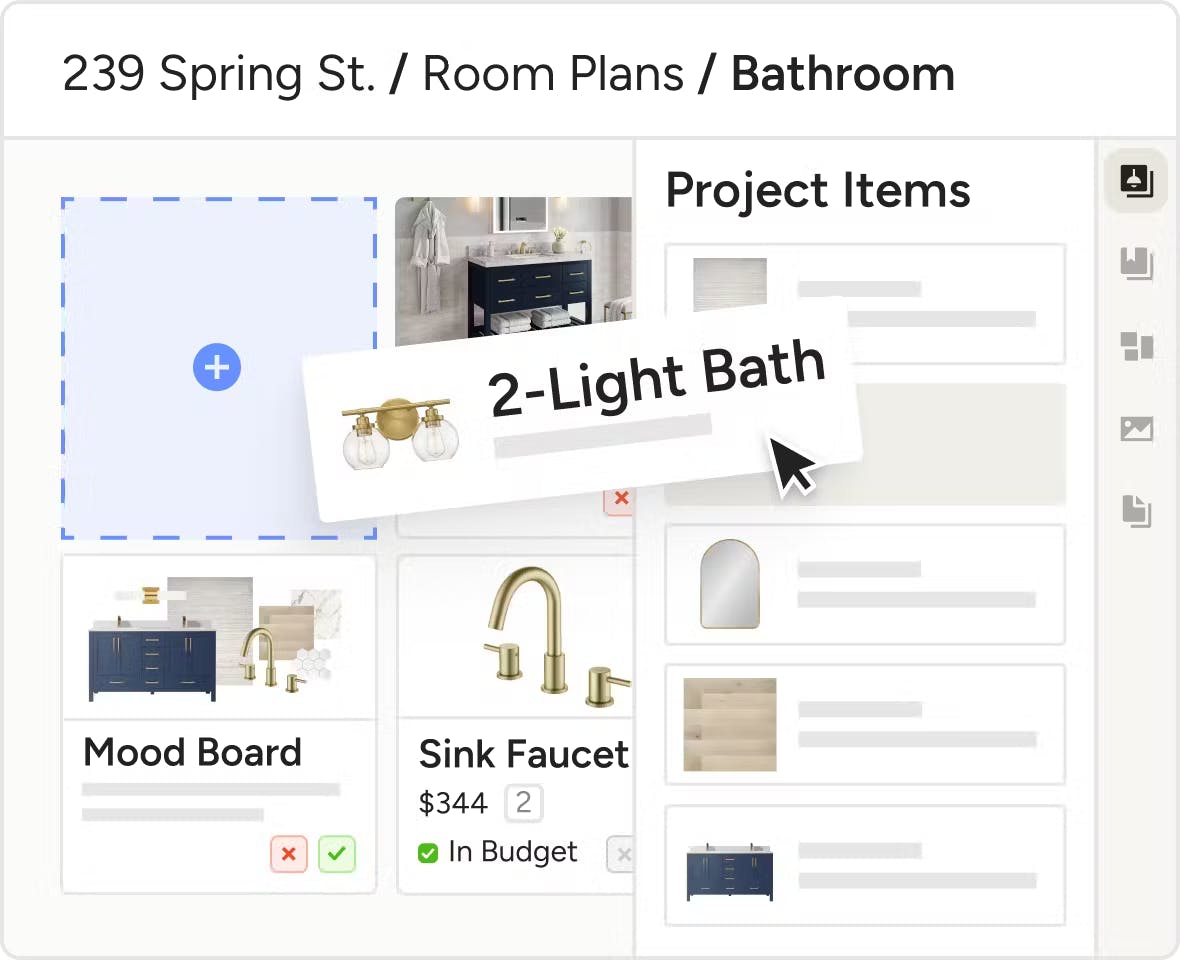How to Create a Winning Interior Design Presentation in Four Steps
Read on to learn the four can’t-miss steps of creating better interior design presentations, including tips on project presentation, design process integration, and visual presentation tools such as mood boards or a floor plan.

Introduction
The interior design presentation is a defining moment for any design project. Done well, the client presentation shows a homeowner in stunning and vivid detail that the designer gets them, their style, their budget and how they want their space transformed.
Designers who make an impactful and professional interior design presentation that perfectly aligns their vision with their client’s expectations are more likely to get a ‘yes’ more swiftly than other designers who have focused less on mastering the skill. We've broken down the art of client presentations into 4 main steps with real examples and tips to help you level up your presentation game.
Step 1: Preparing For Your Interior Design Presentation
Think of this step in the interior design process as if you were painting a room: The time spent cleaning, taping and spackling the space is rewarded with the clean lines and smooth strokes that make for a successful conclusion to the project. Similarly, it may take some time to adequately prepare for a design presentation, but this crucial foundational work sets the direction and basis for the entire project journey ahead.
Where to Start
Client Meeting
- The first step to learning about the needs of a client is to meet with them to gain a full understanding of their design preferences, lifestyle, budget, and the space challenges they are seeking to solve.
- Perhaps they have already filled out an initial questionnaire which you can review with them in more detail. Walk the rooms with them if possible, learn about their preferred colors and materials and their vision for the space. And, of course, ask plenty of clarifying questions along the way.
Define an Early Concept
- With the information from your initial meeting at hand, along with accurate measurements of the space and other important details such as a room’s square footage or other exact dimensions, now is the time to define an initial concept and design direction.
- The overarching concept you come up with will inform the next steps of the design process. At this early stage, you may even pull out a journal or notebook to sketch out a rough idea to use as the basis of a more detailed, digital version later.
Design Development: Crafting a Narrative
- Along with a drawing, write a description of the concept and list the goals to help steer the plan according to your client’s vision and ensure you are on the same page.
Develop Your Design Ideas
Once the rough idea has been determined, it’s time to start moving forward with translating the multiple concepts and design ideas into a project presentation. This is one of the areas that interior designers most enjoy because it gets the creative juices flowing! Many interior designers find inspiration in past projects, from their product library, and through other favorite design sources.
For a professional interior design presentation, choose design elements and different materials that best fit the initial design concept, like color scheme, floor materials, and other specific details such as fabric swatches. Add in the architectural details and supporting elements such as the furniture plan. Demonstrate the spatial relationships within the space and block out the furniture arrangements.

Step 2: Visual Ideas For Building a Professional Presentation
Now that you’ve worked through the early stages of the process, it’s time to learn how to make an interior design presentation as visually compelling as possible. Putting together an effective interior design presentation requires considering how you will organize your ideas to effectively convey them visually.
Most designers find that pulling all of these design concepts together into a visual presentation helps create a full design picture to aid in the project moving forward. Clients more readily understand what they can see; therefore it’s important to carefully select which interior design presentation tools you’ll use to clearly communicate the concepts and ideas. Here are some factors to consider when choosing client presentation tools.
Physical vs. Digital Design Boards
In today’s reality, not all meetings are held in person. Knowing in advance whether the presentation will be physical or virtual can inform the visualization tool choices. Digital design mockups, floor plans and renderings will save the day for making every detail come alive to bridge the internet divide. Using these digital tools is far less clumsy and awkward than trying to hold up a photo album or mockup board to the camera without bumping the mute button.
There’s more flexibility of choice when presenting face-to-face. More often than not, homeowners expect a design firm to make the best use of the sophisticated digital tools that provide life-like representations of what their future space will look like. Designers presenting in person have the advantage of going hybrid. They may, for example, complement these tech methods with fabric swatches and other design board materials that tap into senses beyond the visual.
Most Common Types of Tangible Client Presentation Boards
Physical Design Boards
- Some designers rely on physical mood boards to convey their concepts. Many designers opt for a simple foam board to tack on photographs and other images as well as physical samples and swatches to demonstrate textures and relate their vision.
Material Samples
- Flipping through paint colors, caressing furniture fabrics and squaring up tiles can be a delightful part of the home renovation process. Most clients are grateful to be able to touch, feel and see these physical elements for better visualization. Using a sample board to incorporate tangible textures into your interior design presentation can give you an advantage in winning them over.
Digital Presentation Tools
Interior designers are fortunate to have a host of easy-to-use, effective digital interior design presentation tools available to create presentations that wow.
Mood Boards
- Room designs can be physically conveyed as we discussed above, but virtual mood boards are an impressive tool that inspire clients with visuals and life-like examples. Designers use software to present mood boards to their clients that are easily shared and simple to rearrange with a keystroke.
- Designers source material samples and the actual lamp, sofa, rug or table they envision for the space from their digital product library and preferred vendors. Learn more about How to Make an Interior Design Mood Board to dive deeper.
Floor Plans
- A key part of any presentation is the floor plan, whether it is on paper or a screen. They help show architectural details such as the location of windows, doors, and walls, as well as fully furnish the space with furniture pieces, appliances and fixtures.
- Flat, 2D floor plans and blueprints can do the job, but 3D presentations are worth a thousand words, as they are more powerful for first impressions and help more clients see the entire project design in its best light. Designers who use software to make 3D floor plans incorporate all the details of a room into a compelling, life-like rendering that makes it easy for clients to envision the space. See How To Make Stunning Interior Design 3D Floor Plans for more details.
Photographs
- One of the best ways to help clients believe you can create the transformation they are seeking is through utilize the power of imagery. Presenting photorealistic 3D renderings of the proposed project, or example photos from past projects, will help illustrate your skill and boost their confidence in your interior design business’s work.
- Bonus tip: whenever possible, choose images of the interior design projects most similar to the work they are seeking, whether in scope, budget bracket, type of room or design approach. Check out our piece on How to Make an Interior Design Portfolio to learn more about this complementary presentation skill.

Step 3: Presenting the Vision: How to Impress Design Clients
Now that you have worked through the concepts, gathered all your materials and picked the tools to best convey the design plan, it’s time to tie everything together for an impressive delivery. Consider these interior design presentation tips and strategies to fine tune your delivery.
Tailor Your Presentation
- The scope and content of your presentation will differ depending on your audience. When presenting for the first time to a new client, other designers find it valuable to spend extra time helping them get acquainted with you and the professional design services offered. Cover details of your company values, design approach, makeup of your team, typical scope of projects and any other relevant information.
- For repeat clients, you can start with a brief reminder of these details, as well as draw upon the past work completed for them, being sure to include any references or relation to the requested new project.
Showcase Multiple Concepts
- One size may not fit all. Be prepared with more than one design possibility if you find your first one falling flat, or if your clients express a desire to adjust project scope or compare more options.
- The same holds true for the ways you deliver these concepts. Use multiple methods to help the homeowner visualize and understand the design plan.
Communication Tips
- As the leader of the meeting, set the stage immediately to put clients at ease. Briefly explain the agenda, including at what points you will be seeking feedback. One method that will reassure the homeowner is to pause periodically to ask if they have comments or questions.
- At the same time, avoid getting too bogged down on a single point to ensure there is sufficient time to get through the entire presentation.
The Power of Self-Confidence
- Being self-assured and projecting confidence without talking down to clients signals to them that you are more than qualified for the job, whether you run your own interior design business or represent a larger design firm. Use your communication style to further convey how excited you are about working on their home.
- Dress professionally, but avoid attire that is uncomfortable or inauthentic to who you are - your choice of clothing can have a direct impact on how confident you feel.
Avoiding Game Day Jitters
- While it’s certainly effective to review your agenda one final time prior to your meeting, most designers would recommend allowing yourself a few minutes to clear your head beforehand.
- If you are a caffeine fan, resist the temptation to overload on it - you want to project innate confidence and your natural grounded energy, without being overshadowed by artificial energy or the infamous caffeine jitters.
- And one final interior design presentation tip: shake off any residual nerves by standing up and stretching beforehand, and consider adopting a power stance or two to prime your presentation confidence, especially if you are going to be sitting down throughout the presentation.

Step 4: Enhancing Your Interior Design Presentation: Advanced Tips and Practices
Successful interior design presentations create a memorable first impression that will stay with clients long after you close your laptop and pack your swatches away for the drive home. Effective presenters forge a connection with homeowners on multiple levels through effective use of detail, visualization, lighting and more. Here are some more tips for making your design meeting an impactful one:
Demonstrate Attention to Detail
- Make your presentation accurate and detailed. Show your clients that you have considered every aspect of the project, both big and small. Little details like including the exact dimensions of a project space can help demonstrate your sharpness.
Consider your Client
- Pick moments during the presentation to show your clients that you have thoughtfully considered their feedback. For example, if a homeowner prefers a kitchen island with a sink built in, make note of that as you are highlighting the feature.
- The same goes for places where you chose a less expensive option to be cognizant of their budget constraints: clients love to know that they have been listened to.
Leverage Your Expertise
- Look for opportunities to mention your past experience and skills in a particular area - this is another opportunity to leverage your design portfolio if relevant.
Fine Tune Along the Way
- Have alternative ideas in your back pocket that you can pull out as examples in cases where a client balks at a particular paint color or room layout, for example. This demonstrates both your versatility and flexibility as a design pro.
Remember Ambiance
- Clients will better connect emotionally to a design concept when visualizations include effects such as lighting or even sound. Tap all the senses you can, including the tactile features discussed above.
Let’s Get Visual
- The more you can show and not tell, the more connected your clients will be to the presentation. Visualization is not only entertaining, it helps homeowners better understand the concepts and vision.
Imprint Your Brand
- Presentations which are consistent with incorporating logos, company colors and other branding details are more pleasing on the eye, and also leave clients with a lasting impression.

Next Steps: Client Follow up
Before tying a bow on the interior design presentation, set the agenda for what happens next. This may include noting methods for receiving additional feedback and setting a timeline for project signoff. If the clients suggested any major changes during the presentation, let them know when they will receive a revised plan.
Depending on the project, more measurements and additional details may be needed to determine a final budget. And, make it as easy as possible for clients to approve the plans by providing them a way to sign off with an e-signature.
Conclusion
Making effective interior design presentations is one of the best routes toward achieving client satisfaction, securing new clients and keeping current ones coming back for more. Impactful presentations are highly visual, pay close attention to the homeowner’s desires and budget, and provide clients a compelling glimpse of what their space will look like at the project’s end. As a result, mood boards play a central role in every interior designer presentation; if you’re ready to step up your presentation game, try Houzz Pro’s mood board software for the most effortless experience in crafting professional mood boards.

Want advice delivered to your inbox?
Unlock industry insights and updates for contractors and design pros
By signing up, I agree to the Houzz Terms of Use and Privacy Policy and that Houzz may use my information to contact me about relevant content, products, and services.





Join the conversation by commenting or asking a question below. The Houzz team reads every single comment, and we’ll get back to you by email if you need us!